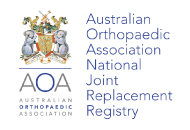Home
The Australian Orthopaedic Association National Joint Replacement Registry (AOANJRR) is an initiative of the Australian Orthopaedic Association (AOA). The AOANJRR was established in 1999 becoming fully national in mid 2002. The purpose of the AOANJRR is to improve and maintain the quality of care for individuals receiving joint replacement surgery. Information on hip, knee, shoulder, elbow, wrist, ankle and spinal disc replacement is collected from all hospitals in Australia undertaking joint replacement surgery.
The Commonwealth of Australia has declared the AOANJRR a Federal Quality Assurance Activity under part VC of the Health Insurance Act, 1973.
The AOANJRR is funded by the Commonwealth Department of Health and Aged Care.
Registry Clinical Director
Professor Paul Smith
Deputy Registry Clinical Directors
Associate Professor Peter Lewis
Adjunct Professor Michael McAuliffe
Assistant Deputy Registry Clinical Directors
Mr James Stoney
Dr David Gill (Upper Limb)
Associate Professor Chris Wall
Clinical Advisor (as required)
Mr Peter Stavrou
Acting Registry Executive Manager
Sophie Corfield
General Enquiries:
Please direct all enquiries to the Executive Manager Registry Services:
E: executivesupport@aoanjrr.org.au
T: +61 8 8128 4280
AOANJRR Releases 2025 Annual Report
26th Edition Marks New Insights into Revision Surgery
The Australian Orthopaedic Association National Joint Replacement Registry (AOANJRR) has released the 2025 Hip, Knee, and Shoulder Arthroplasty Annual Report, its 26th edition. Since 1999, the Registry has recorded more than 2.28 million procedures, providing an unparalleled evidence base that has transformed orthopaedic care in Australia and internationally.
This year's report introduces a special chapter on aseptic revision hip, knee, and shoulder replacement, offering the most detailed analysis to date of outcomes following revision procedures. Alongside the main report, the AOANJRR has also published 14 supplementary reports, including the inaugural Shoulder Replacement in Australia report, which consolidates all Registry shoulder data into a single, accessible resource.
The AOANJRR remains committed to improving joint replacement outcomes by delivering trusted data to surgeons, healthcare providers, researchers and policymakers.
The 2025 Annual Report and the 14 supplementary reports are available for free download on the AOANJRR website.


